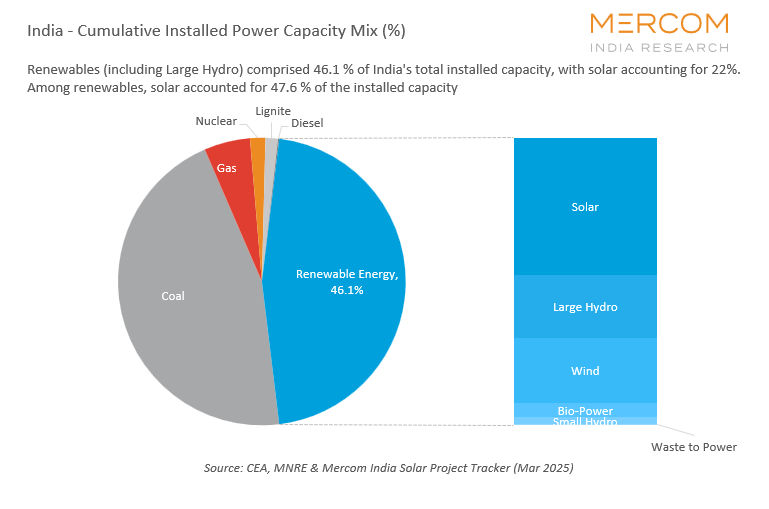Solar’s Share in India’s Renewable Energy Capacity Increases to 47.6% in Q1 2025
Renewables accounted for a 46.1 % share of the overall power capacity mix
May 14, 2025
Follow Mercom India on WhatsApp for exclusive updates on clean energy news and insights
Solar power accounted for 22% of India’s total installed power capacity and 47.6% of the total installed renewable energy capacity at the end of the first quarter (Q1) of the calendar year 2025. The share of solar power in the total power capacity increased by 6.8% quarter-over-quarter (QoQ) and 27.3% year-over-year (YoY).
India’s renewable energy capacity, including large hydroelectric projects, accounted for 46.1% of the cumulative power capacity, with 218.6 GW installed at the end of Q1, according to data from the Central Electricity Authority (CEA), the Ministry of New and Renewable Energy (MNRE), and Mercom’s India Solar Project Tracker.
The share of renewable energy in the power mix increased from 209.1 GW, representing 44.1% of the overall power capacity, in the previous quarter. The capacity increased from 190.6 GW at the end of Q1 2024, when it comprised 43.2% of the overall power capacity.
India generated approximately 42 billion units (BU) of solar power during the quarter, compared to 35.2 BU in Q4 2024.
As of March 2025, large hydro, with a total installed capacity of 47.7 GW, accounted for nearly 10.1% of the total installed power capacity.
Wind installations in India totaled 50 GW, accounting for 10.6% of the country’s overall installed power capacity.
Biomass and small hydro contributed 2.3% and 1.1% to the total installed power capacity as of March 2025, respectively.
Energy from conventional sources
At the end of Q1 2025, India’s installed conventional power capacity stood at 255.1 GW, accounting for 53.9% of all installations. This installed capacity represents a decrease from 54.7% in the previous quarter and 56.8% in the same period last year.
The electricity generated from thermal sources includes coal (45.4%), gas (5.2%), nuclear (1.7%), lignite (1.4%), and diesel (0.12%). Although conventional power’s total installed capacity decreased, coal-based power projects’ installed capacity rose 1.3% during the quarter.
The coal-based power plants commissioned in Q1 2025 included units at THDC’s Khurja STPP, TSGENCO’s Yadadri TPS, MAHAGENCO’s Bhusawal TPS, and UPRVUNL’s Panki TPS Extension, as well as KPCL’s Yelahanka CCPP, resulting in a total of 2.8 GW commissioning in Q1 2025.
During the quarter, decommissioning activities at gas-based thermal installations resulted in a 1.1% decrease in installed capacity.
Despite its significant installed capacity, the decline in conventional power’s share underscores the country’s growing expansion of renewable energy. With the rising share of variable solar and wind power in the energy mix, energy storage systems are emerging as a critical enabler, helping bridge the gap between generation and consumption while maintaining grid balance.
Last August, Rajasthan became the first state in India to achieve more than 50% solar in its total installed power capacity, according to Mercom’s India Solar Project Tracker. The state had approximately 23 GW of solar capacity, representing 51% of its total installed power capacity. Solar accounted for 76% of its total installed renewable energy capacity.

